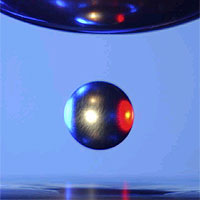Solar + Battery Car DIY STEM Kit
$11.99$5.95
Posted on: Jul 2, 2003

NASA-funded researchers recently obtained the first complete proof of a 50-year-old hypothesis explaining how liquid metals resist turning into solids.
The research is featured on the cover of the July issue of Physics Today. It challenges theories about how crystals form by a process called nucleation, important in everything from materials to biological systems.
"Nucleation is everywhere," said Dr. Kenneth Kelton, the physics professor who leads a research team from Washington University in St. Louis. "It's the major way physical systems change from one phase to another. The better we understand it, the better we can tailor the properties of materials to meet specific needs," he said.
Using the Electrostatic Levitator at NASA's Marshall Space Flight Center in Huntsville, Ala., Kelton's team proved the hypothesis by focusing on the "nucleation barrier." German physicist Gabriel D. Fahrenheit, while working on his temperature scale, first observed the barrier in the 1700s. When he cooled water below freezing, it didn't immediately turn into ice but hung around as liquid in a supercooled state. That's because it took a while for all the atoms to do an atomic "shuffle" arranging in patterns to form ice crystals.
In 1950, Dr. David Turnbull and Dr. Robert Cech, researchers at the General Electric Company in Schenectady, N.Y., showed liquid metals also resist turning into solids. In 1952, physicist Dr. Charles Frank, of the University of Bristol in England, explained this "undercooling" behavior as a fundamental mismatch in the way atoms arrange themselves in the liquid and solid phases. Atoms in a liquid metal are put together into the form of an icosahedron, a pattern with 20 triangular faces that can't be arranged to form a regular crystal.
"The metal doesn't change to a solid instantly, because it costs energy for the atoms to move from the icosahedral formation in the liquid to a new pattern that results in a regular crystal structure in the solid metal," explained Kelton. "It's like being in a valley and having to climb over a mountain to get to the next valley. You expend energy to get over the barrier to a new place," he said.
Frank didn't know about quasicrystals, first discovered in 1984, and researchers didn't have tools like NASA's Electrostatic Levitator. Using electrostatic energy to levitate the sample was crucial, because stray contamination from containers cause crystals to form inside liquid metals, which would have ruined Kelton's measurements on pure samples.
To measure atom locations inside a drop of titanium-zirconium-nickel alloy, the levitator was moved to the Advanced Photon Source at Argonne National Laboratory in Chicago. There, an energetic beam of X-rays was used to map the average atom locations as the metal turned from liquid to solid. The experiment was repeated several times, and the data definitively verified Frank's hypothesis.
As the temperature was decreased to solidify the molten sample, an icosahedral local structure developed in the liquid metal. It cost less energy to form the quasicrystal, because it had an icosahedral structure. This caused the quasicrystal to nucleate first, even though it was less stable than the crystal phase that should have formed. The icosahedral liquid structure was therefore directly linked to the nucleation barrier, as proposed by Frank.
To prepare for an International Space Station experiment, the team is continuing levitator experiments. The new techniques being developed for these studies can be applied to solve advanced materials problems on Earth and for spacecraft applications.
"As NASA scientists develop advanced materials for rocket engines and spacecraft, our facility will be a technological tool they can use to characterize materials," said Dr. Jan Rogers, a Marshall Center scientist who assisted Kelton's research team.
Kelton's team at Washington University included Geun Wu Lee, a graduate student, and Anup Gangopadhyay, a research scientist; Jan Rogers, Tom Rathz and Mike Robinson, all of the Marshall Center; Robert Hyers, University of Massachusetts, Amherst; and Doug Robinson, Ames Laboratory, U.S. Department of Energy, Ames, Iowa.
Kelton conducts his research under NASA's Materials Science Program managed by the Marshall Center. The research is funded by the Physical Science Research Program — part of NASA's Office of Biological and Physical Research in Washington, D.C., the Marshall Center Director's Discretionary Fund and Internal Research and Development funds from the Marshall Center's Science Directorate.
A peer-reviewed article that discusses this work appeared in the May 16 issue of Physical Review Letters. The research was featured in the May 30 issue of Science.
 'I beseech you to take interest in these sacred domains so expressively called laboratories. Ask that there be more and that they be adorned for these are the temples of the future, wealth and well-being. It is here that humanity will grow, strengthen and improve. Here, humanity will learn to read progress and individual harmony in the works of nature, while humanity's own works are all too often those of barbarism, fanaticism and destruction.'
'I beseech you to take interest in these sacred domains so expressively called laboratories. Ask that there be more and that they be adorned for these are the temples of the future, wealth and well-being. It is here that humanity will grow, strengthen and improve. Here, humanity will learn to read progress and individual harmony in the works of nature, while humanity's own works are all too often those of barbarism, fanaticism and destruction.'